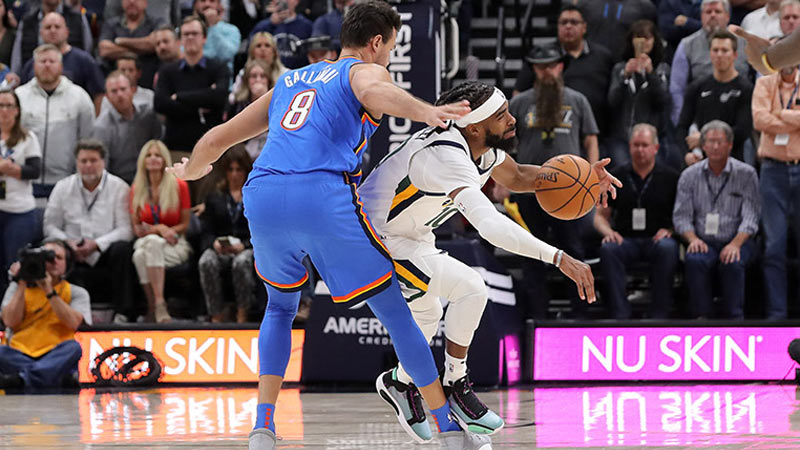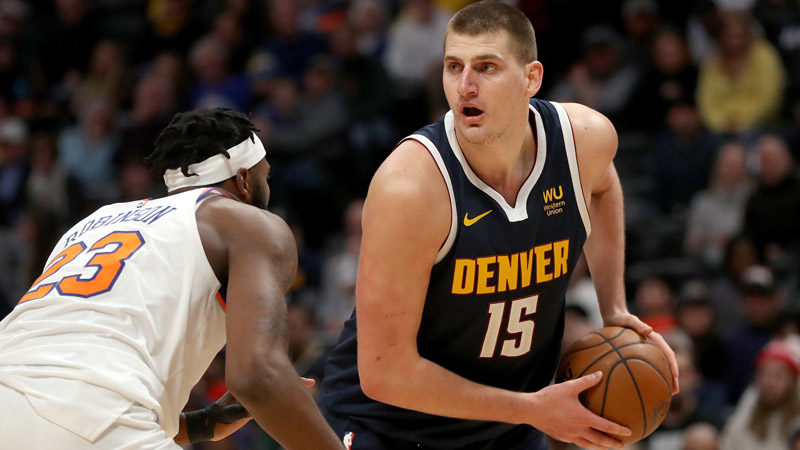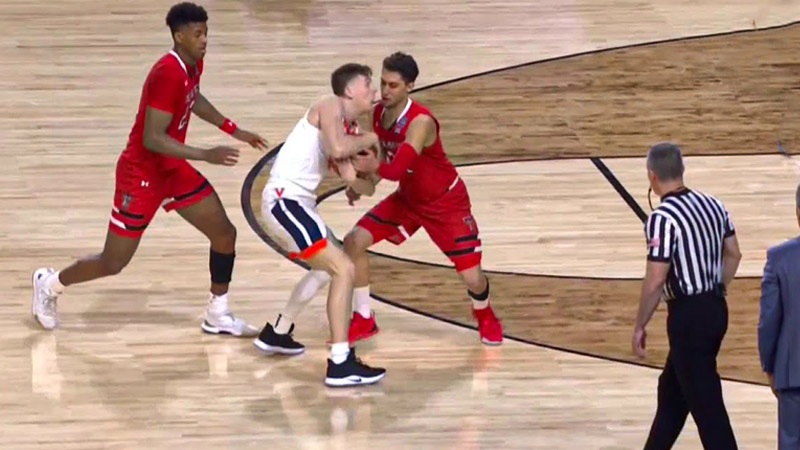The held ball is a common occurrence in the fast-paced game of basketball. It happens when two opposing players simultaneously gain possession of the ball, leading to a deadlock.
This situation calls for a jump ball, where the referee intervenes to determine which team will gain possession. Held ball situations often arise during intense battles for rebounds or loose balls, adding excitement and competitiveness to the game.
In this blog post, we will explore the concept of held ball in basketball, its rules, and its impact on gameplay. So, stay with us till the end.
What is Held Ball in Basketball?
In basketball, a “held ball” occurs when two opposing players gain possession of the ball simultaneously and neither player is able to establish control or make a play.
When a held ball situation arises, the referee will blow the whistle and signal a jump ball. In this situation, the possession arrow determines which team will gain possession of the ball after the jump ball.
The possession arrow is usually displayed on the scoreboard, alternating between the teams each time a held ball is called. However, in some basketball leagues, such as the NBA, a jump ball will occur at the center circle to determine possession.
Held ball situations often arise during intense battles for rebounds or loose balls, and they provide a fair way to determine which team gets possession when neither player has clear control.
What Is the NBA Rule on Held Ball in Basketball?

Source: actionnetwork.com
In the National Basketball Association (NBA), the rules regarding held ball situations differ slightly from other basketball leagues. In the NBA, a held ball occurs when two opposing players gain simultaneous possession of the ball, resulting in a deadlock. The NBA has specific rules to address these situations and determine possession.
When a held ball occurs, instead of relying on the possession arrow like in many other leagues, the NBA employs a jump ball to determine possession. The jump ball takes place at the center circle, with the referee tossing the ball into the air between two players involved in the held ball situation.
During the jump ball, the two players involved in the held ball must make a reasonable attempt to tip or gain control of the ball. Once the ball is tipped or controlled by one player, the jump ball situation ends, and that player’s team gains possession of the ball.
It’s important to note that in the NBA, jump balls are not just limited to held-ball situations. They also occur to start each game, at the beginning of each overtime period, and in certain other scenarios determined by the referees.
The NBA’s approach to held ball situations through jump balls adds an element of excitement and competition to the game. It eliminates the reliance on possession arrows and provides an opportunity for players to showcase their skills in tipping or gaining control of the ball to secure possession for their team.
How to Determine a Held Ball in Basketball?
A held ball occurs when two opposing players gain simultaneous possession of the ball, resulting in a temporary pause in play.
The determination of a held ball is crucial as it dictates possession and can lead to jumping ball situations or alternating possessions. To determine a held ball, referees closely observe the situation and consider various factors:
Simultaneous Possession
The primary criterion for a held ball is when both players involved have a firm grip on the ball, preventing either from gaining control or attempting a legal play.
If both players have hands securely on the ball, it indicates a situation of simultaneous possession.
Timeframe
Referees assess the duration of the player’s possession. If the players quickly release the ball or fail to gain full control, it may not be deemed a held ball. Sustained possession with a firm grip is more indicative of a held ball.
Lack of Progress
Referees pay attention to the progress made by the players involved in the held-ball situation. They observe if any player is actively attempting to gain an advantageous position or execute a legal play.
If the players are merely engaged in a struggle for control without making any significant progress, it is more likely to be called a held ball.
How Do NBA Players Hold the Ball?

Source: fansided.com
In the NBA, players utilize various techniques to secure possession of the ball during held-ball situations. These techniques are aimed at maintaining control, preventing the opponent from dislodging the ball, and forcing a jump ball or gaining alternating possessions:
Two-Handed Grip
The most fundamental approach is for players to use a two-handed grip. They tightly wrap both hands around the ball, distributing their fingers and palms to create a secure hold.
This technique provides stability and allows players to maintain control even when faced with defensive pressure.
Chin the Ball
To add an extra layer of security, players often tuck the ball under their chin or against their chest while maintaining a two-handed grip.
By utilizing their chin or chest as a point of contact, players can create a strong anchor and reduce the risk of opponents knocking the ball loose.
Elbows Out
NBA players may extend their elbows outward while holding the ball. This technique not only helps create a wider defensive stance but also serves as a physical barrier, making it more challenging for opponents to reach in and dislodge the ball.
By keeping their elbows out, players create a protective space around the ball, increasing their chances of retaining possession.
These techniques, combined with the strength, agility, and body control of NBA players, enable them to secure the ball effectively during held-ball situations.
The ability to maintain possession is crucial, as it can lead to favorable outcomes such as forcing a jump ball or gaining alternating possessions, allowing teams to retain control and continue their offensive or defensive strategies.
What Are the Results of a Held Ball in Basketball?
When a held ball is called in basketball, several outcomes and scenarios may unfold, impacting possession and the flow of the game. The specific results of a held ball depend on the league or competition rules, but some common scenarios include:
Jump Ball
If the held ball situation is deemed a tie, neither team is awarded possession. In this case, a jump ball is conducted at the center circle.
Two players from opposing teams compete to gain possession by tapping the ball to their teammates. This method is often used in situations where the held ball occurs near the center of the court.
Alternating Possession
Some leagues employ the alternating possession rule. In this scenario, a held ball results in a change of possession. The team that did not have possession before the held ball is awarded possession.
Additionally, an alternating possession arrow is used to indicate which team will receive the ball in subsequent tied-ball situations. This rule ensures fairness by alternating possession between teams after held-ball situations.
Reset Shot Clock
In certain cases, when a held ball occurs and the offensive team is not awarded a new possession, the shot clock is reset to a specified time. This allows the team to continue their offensive possession and have a fresh opportunity to score.
The exact time reset may vary depending on league rules, but it typically gives the offensive team enough time to execute a play.
Significance of Held Ball in Basketball
Held ball situations hold significant importance in basketball for several reasons:
Fairness and Possession Determination
Held balls provide a fair and objective way to determine possession when two opposing players have simultaneous possession of the ball. It prevents disputes and ensures that both teams have an equal chance to gain possession.
Competitive Intensity
Held ball situations often arise during intense battles for rebounds or loose balls. They add an extra layer of competitiveness to the game, as players fight to gain control and secure possession for their team. These moments can be pivotal in determining the outcome of a game.
Showcasing Player Skills
Held ball situations allow players to showcase their skills and athleticism. It requires players to demonstrate their strength, agility, and technique to gain control of the ball or tip it to their teammates during jump ball scenarios.
Strategic Opportunities
Coaches and players can use held-ball situations strategically. They can call timeouts to retain or change possession, set up specific plays, or adjust their game plan based on the possession arrow or the outcome of the jump ball.
Momentum Shifts
Held ball situations can lead to momentum shifts in a game. If a team gains possession after a held ball, it can swing the momentum in their favor, energizing both the players and the crowd. Conversely, losing possession in a held-ball scenario can deflate a team and provide an advantage to the opponent.
Held ball situations play a significant role in basketball, providing fairness, intensity, skill display, strategic opportunities, and the potential for momentum swings. They contribute to the dynamics and excitement of the game, making basketball more thrilling and engaging for players and fans alike.
FAQs
What triggers a held-ball situation in basketball?
A held ball situation is triggered when two opposing players simultaneously gain possession of the ball, but neither player is able to establish control or make a play. This often happens during intense battles for rebounds or loose balls.
How is possession determined in a held-ball situation?
Possession is determined by the possession arrow, which is usually displayed on the scoreboard. When a held ball is called, the team that is indicated by the possession arrow as having the next possession will gain the ball after a jump ball.
Can a player call a timeout during a held ball?
Yes, players or coaches can call a timeout during a held-ball situation. By calling a timeout, they can either retain possession of the ball or strategize to change possession and gain a tactical advantage.
Are there any exceptions to the jump ball rule?
Yes, in some basketball leagues, such as the NBA, the jump ball rule is applied differently. Instead of using the possession arrow, a jump ball occurs at the center circle to determine possession in held-ball situations.
What if a held ball situation occurs during overtime?
In overtime, the jump ball rule is often used to determine the initial possession. After the initial jump ball, the possession arrow rules apply, just as they do during regulation play. This ensures a fair distribution of possessions throughout the overtime period.
Bottom Line
Held ball situations are an integral part of basketball, providing a fair way to determine possession when two players simultaneously gain control of the ball. The jump ball and possession arrow rules ensure a balanced and competitive game.
Whether it’s a battle for a rebound or a scramble for a loose ball, the held ball adds intensity and unpredictability to basketball, keeping players and fans on the edge of their seats.
Understanding the rules surrounding held-ball situations helps fans appreciate the game’s dynamics and the strategies employed by teams to gain possession and maintain control.







